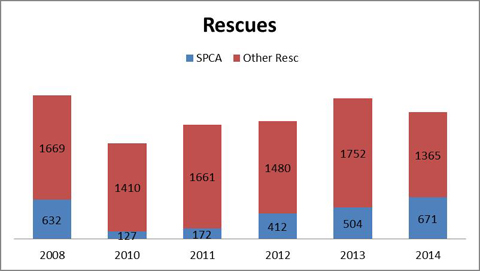
(See 2015 Final Report)
As for how it was in 2012 ...

There are two ways for cats to be discharged from HAS. Some cats (remarkably few) are reclaimed by owners and a large number are transferred to organization that run adoption services. Based on comparisons with previous years (2013 to as far back as 2006), one can draw the following conclusions.
In 2014, 96 of the 2,132 strays (3.9%) were reclaimed by owners. While the return-to owner #s fluctuates a bit, with 151 of the of the 3,908 cats at HAS (3.9%) reclaimed in 2012 and 119 of the 3,384 cats (3.4%) in 2013, the return-to-owner rate remains around 3.9%. There are no indications of any significant change; the rate has consistently remained in the 3.9% range.
HAS has never had it's own adoption centre. Instead it operates on a model whereby adoptable cats are transferred to organizations that run adoption services. This arrangement involves a co-operative effort with the HBSPCA and a number of "approved" Rescue Groups. In 2014, a total of 2,036 cats (72% of the Total Intake) were transferred out to these organizations, with the HBSPCA taking 671 (33%) and the Other Groups (combined) taking 1,365 cats. Looking back over past years, two points emerge:
- The HBSPCA has, for 5 consecutive years, been increasing the # of cats transferred from HAS into their adoption program.
-The Other Rescues fluctuate year by year and, in 2014, their rescue # was significantly down from last year's total of 1,752 and from the average (over the past 8 years) of 1,567.
The points made below will provide a clearer picture, and some understanding of the implications, of what is happening currently regarding dischange.
Looking, first, at the return-to-owner rate, it is evident that it remains disappointingly low. There is no way to tell how many of the cats ending up classified at HAS as "strays" were actually unclaimed owned cats but it seems likely that many were and that it is reasonable to conclude that far too few cats are getting back home.
How many lost cats get to go back home is generally seen to be entirely the responsibility of HAS. But that's not the case; the reality is that getting cats back to their owners relies heavily on pet owners providing ID and actively searching.When there is no way to contact the owner, all that HAS can do is post the cat on the Lost & Found website.
Return to Owner (RTO) numbers remain disturbingly low, serving as a reminder to Hamilton pet owners to do all they can to prevent their cats from this fate - to keep them inside (if they can), provide ID (including microchips), and actively search [For more info]
All unclaimed cats need homes. HAS does not have an adoption service. There is a long standing belief that, because other animal services do have adoption services, HAS needs one too. The answer over the years has been that HAS "does not have the resources to offer an Adoption Services." This has aroused frustration and anger and led to speculation about what's "wrong" with this City.
However this is a complex issue and it may be that, in this City, there may be other (better) options. One difference between animal services in Hamilton and services in other city is the proximity of HAS to HBSPCA which operates a successful adoption service. These two seperate organizations occupy the same building and there is a cooperative agreement in effect whereby the HBSPCA transfers adoptable HAS cats into their service. As the chart below illustrates the # being transferred over has been, over the past 5 years, consistently increasing. 
From the chart, it is evident that HBSPCA's rescue #s have fluctuated considerably. However, in 2011, the #s began to rise at first slowly and then progressively more sharply. This significant rise reflects changes within HBSPCA, including a renovation in 2011 that doubled the in-shelter capacity for cats, innovative initiatives to increase adoptions, and the establishment of, in addition to their active on-site adoption centre, 5 off-site adoption locations. Most HBSPCA cats come from HAS and the fact that in 2014 33% of those discharged from HAS to adoption services were taken into the care of this organization signals a significant shift. And, given that at the start of 2015, the HBSPCA has 'in the works' plans for 2 more off-site locations, it's looks hopeful that the arrangement with the HBSPCA will continue to benefit large #s of HAS cats.
While it's obvious that HAS cats rely heavily on the efforts of the Other Rescues, the #s give a less clear picture of what's happening and some cause for concern. The 2014 stats show a significant decline (of 387) from the previous year and the lowest point in 6 years. Many variables influence the numbers any one of these groups can take and further information is needed to draw any conclusions. Because this total # of transfers is a combination of local and out of town rescue #s, one needs to ask whether the decline reflects a drop in the #s local groups are taking or a downward shift in the #s out-of-town groups are taking.
For privacy reasons this breakdown is not available to the public so all that can be done here is to raise a couple of possibilities.
If the decline is primarily in local #s, it could mean that local rescues are deciding to focus more on taking cats into their care BEFORE they enter HAS.
If the decline is primarily in out-of-town groups, this could be due to word spreading about the dramatically reduced euthanized rate at HAS, causing these groups to shift their efforts to other municipalities where conditions are worse.

To keep up-to-date on return-to-owner,#s and transfers to HBSPCA and these Other Rescues see the ticker-tape (at the bottom of tthe Home page). As of January 2015 these updates are posted monthly.
